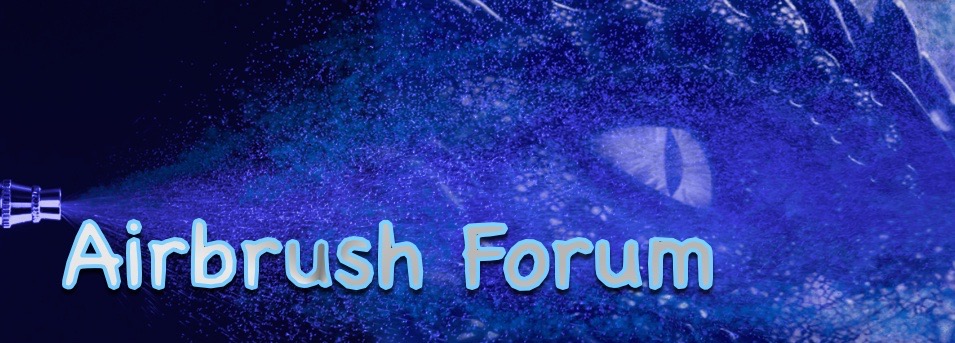T
tljbcrew
Guest
Hey guys, Todd here 38 from Kansas City. I bought an RC Car for my son at Christmas. Reading about them I came across people who paint them. I thought that was pretty neat but when I came across airbrushing them I was hooked. Not necessarily for the RC cars but just a learning it in general. That's when my hobby hunt began. I have spent hours over the last month online researching first and watching many videos. Thanks to some youtube searches I found Airbrush Tutor.
I had a shop setup years ago that I was able to convert into what I needed for airbrushing.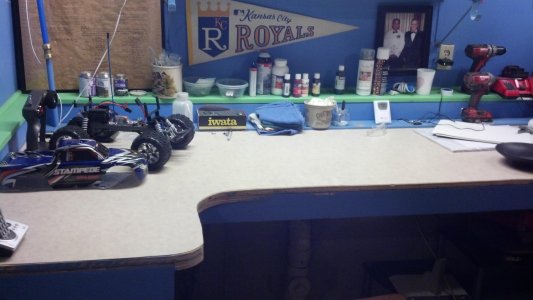
I take a large 1/2 poster board and clamp it to the bench then I tape my practice sheets to it. So far it seems to work. And following AT's advice I made it pretty comfortable.
After tons of research and of course watching AT's video's I went ahead and purchased an iWata gravity fed, Revolution CS. I felt with wanting to attack smaller projects I didn't want a siphon fed. So far this seems to work good I guess, hard to tell given I have never touched one before. I also very much appreciated AT's video about how to break one down, have the diagram handy, and oil the pieces. At first, I was pretty intimidated due to the small pieces but after watching the video and doing the breakdown it was very simple.
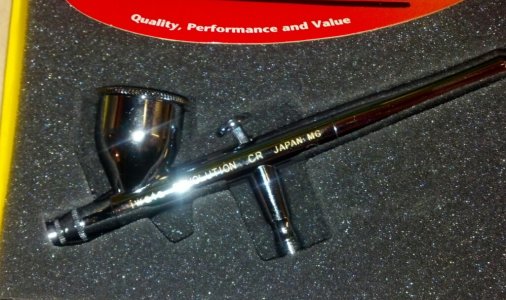
The paints I started with are all water based. Following some advice I went with Createx because of cost and one from Badger (Air-Opaque Airbrush Ready).
I also, thanks to the AT video's installed a regulator from my main compressor in the garage and ran a separate line to my work space. The compressor had one on it already but man I am glad I went this route. I can easily control everything right where I am working.
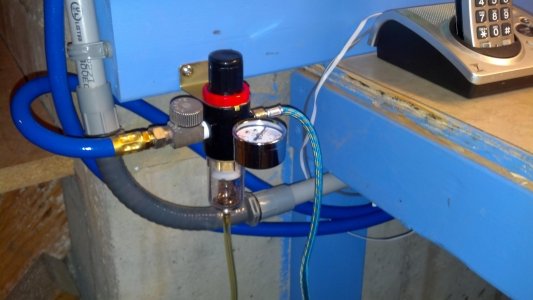
I just kicked off my first practice today after downloading your FREE worksheets woohoo. Got to love free stuff!!! Needless to say practicing seemed to create a ton of questions, all of which I found on this forum and am working out the kinks. The sheets look a little crazy because I was contending with some issues and just kept flowing paint to figure them out.
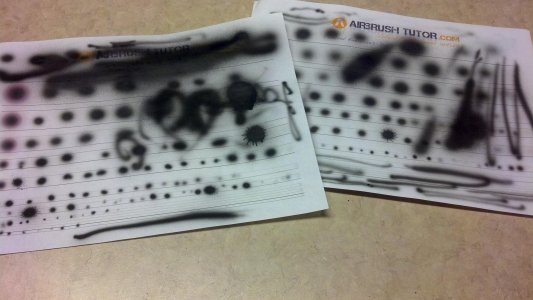
Sorry for such a long post but I am pretty damn excited to be doing this and being part of this forum to help along the way. Some of the things I am working through after today are basic over spray problems. There are a lot of variables so it is hard to ask the right question until I pin down which ones might be causing problems.
1. My work space is about 62 degrees so maybe the paint is too cold, so I got a heater down there to raise the temp, now it's 72 so it cozier but still had over spray.
2. Ahhh the dreaded PSI debate, I found a load of info here on that topic. I started with 40 PSI, so I tested many practice sheets with adjusting it to 35, 30, 25 and so on down to 5 psi. Still had overspray but it did give me a great feel for the range of options depending on what I will be working on. The best seemed to be 25 until I got to the really fine circles on the practice sheets, then I did good at 15.
3. Then I read about thinning the paint but am still somewhat confused. I read somewhere that Createx didn't need to be thinned but others said to do so. The ratios I hear are all over the place but the one constant I hear of course is just make it a consistency of milk. So I think I am there. I tried different thinning ratios and even switched from Createx to badger but still had over spray.
3. Movement, I might have to post a video of me airbrushing, I could have too slow of a speed. But I did some practice with various speeds. I only got good clean lines when I went really fast. I can't imagine airbrushing like this, kind of made my head spin.
4. I think I have narrowed it down to my airbrush itself. I disassembled all of the parts and wiped them down so there was no excess oil, looked for any drying on the tip which I did find. That might have been it. I also think I made a rookie mistake and pulled the needle out with paint still in the cup. Oops, yeah that cleanup took a bit of time. I drew paint into the back end and allowed paint to drip out of the front.
Everything is dry, cleaned, oiled, and put back together. This week I'll keep trying different things. If you guys have any tips after reading all of this let me know.
I guess I do have two questions.
1. I didn't feel I painted very long so I was surprised I did find paint dried on the needle point. It was an ever so fine spec of paint. Can even the smallest piece of dry paint cause that much over spray? Or maybe I am beating myself up and that amount of over spray is A-OK.
2. At what angle do most artists hold their airbrush? I have noticed I got in the habit of holding it almost completely horizontal. I lowed my practice sheets so my airbrush was at a slight angle (almost exactly how it is pictured). I made sure I kept the cup level, that seems to be the right way to hold it. Not sure.
Again, sorry for the long point. I can't wait to get going.
I had a shop setup years ago that I was able to convert into what I needed for airbrushing.

I take a large 1/2 poster board and clamp it to the bench then I tape my practice sheets to it. So far it seems to work. And following AT's advice I made it pretty comfortable.
After tons of research and of course watching AT's video's I went ahead and purchased an iWata gravity fed, Revolution CS. I felt with wanting to attack smaller projects I didn't want a siphon fed. So far this seems to work good I guess, hard to tell given I have never touched one before. I also very much appreciated AT's video about how to break one down, have the diagram handy, and oil the pieces. At first, I was pretty intimidated due to the small pieces but after watching the video and doing the breakdown it was very simple.

The paints I started with are all water based. Following some advice I went with Createx because of cost and one from Badger (Air-Opaque Airbrush Ready).
I also, thanks to the AT video's installed a regulator from my main compressor in the garage and ran a separate line to my work space. The compressor had one on it already but man I am glad I went this route. I can easily control everything right where I am working.

I just kicked off my first practice today after downloading your FREE worksheets woohoo. Got to love free stuff!!! Needless to say practicing seemed to create a ton of questions, all of which I found on this forum and am working out the kinks. The sheets look a little crazy because I was contending with some issues and just kept flowing paint to figure them out.

Sorry for such a long post but I am pretty damn excited to be doing this and being part of this forum to help along the way. Some of the things I am working through after today are basic over spray problems. There are a lot of variables so it is hard to ask the right question until I pin down which ones might be causing problems.
1. My work space is about 62 degrees so maybe the paint is too cold, so I got a heater down there to raise the temp, now it's 72 so it cozier but still had over spray.
2. Ahhh the dreaded PSI debate, I found a load of info here on that topic. I started with 40 PSI, so I tested many practice sheets with adjusting it to 35, 30, 25 and so on down to 5 psi. Still had overspray but it did give me a great feel for the range of options depending on what I will be working on. The best seemed to be 25 until I got to the really fine circles on the practice sheets, then I did good at 15.
3. Then I read about thinning the paint but am still somewhat confused. I read somewhere that Createx didn't need to be thinned but others said to do so. The ratios I hear are all over the place but the one constant I hear of course is just make it a consistency of milk. So I think I am there. I tried different thinning ratios and even switched from Createx to badger but still had over spray.
3. Movement, I might have to post a video of me airbrushing, I could have too slow of a speed. But I did some practice with various speeds. I only got good clean lines when I went really fast. I can't imagine airbrushing like this, kind of made my head spin.
4. I think I have narrowed it down to my airbrush itself. I disassembled all of the parts and wiped them down so there was no excess oil, looked for any drying on the tip which I did find. That might have been it. I also think I made a rookie mistake and pulled the needle out with paint still in the cup. Oops, yeah that cleanup took a bit of time. I drew paint into the back end and allowed paint to drip out of the front.
Everything is dry, cleaned, oiled, and put back together. This week I'll keep trying different things. If you guys have any tips after reading all of this let me know.
I guess I do have two questions.
1. I didn't feel I painted very long so I was surprised I did find paint dried on the needle point. It was an ever so fine spec of paint. Can even the smallest piece of dry paint cause that much over spray? Or maybe I am beating myself up and that amount of over spray is A-OK.
2. At what angle do most artists hold their airbrush? I have noticed I got in the habit of holding it almost completely horizontal. I lowed my practice sheets so my airbrush was at a slight angle (almost exactly how it is pictured). I made sure I kept the cup level, that seems to be the right way to hold it. Not sure.
Again, sorry for the long point. I can't wait to get going.
